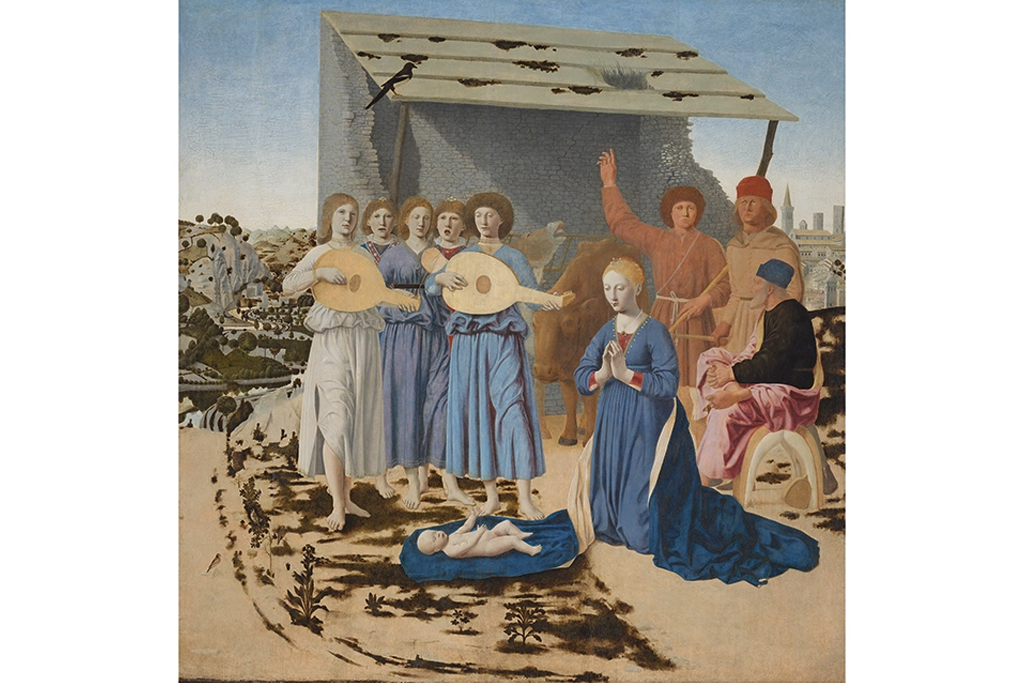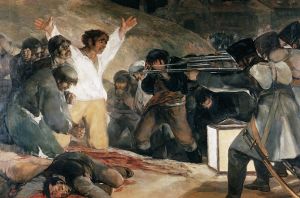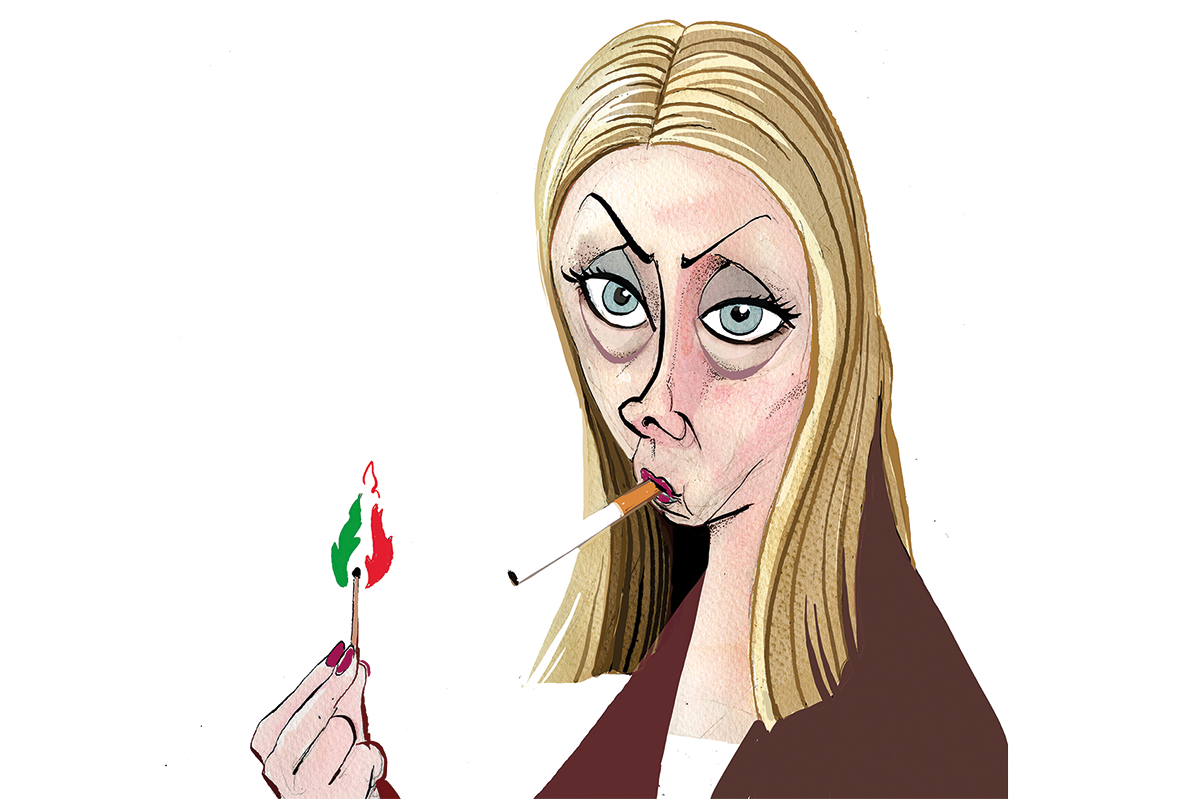When I first saw “The Triumph of Death” (1562-63), by Pieter Bruegel the Elder, the painting throbbed: this land was sick, smothered in smoke; the fires on the horizon had been burning for ever, turning earth into dirt, air into haze. All was dull, lethargic, ill.
When I saw the painting again some years later, the smoke had cleared. Patches of green pushed up from the canvas; the peasantry’s clothes were suddenly bright; the sun appeared to exist. In its new clarity, some of the painting’s jaded horror had been replaced by a sort of comedy. The work had been restored, but something had been lost.
That “something” is much easier to identify in the National Gallery, London’s recent — and much criticized — restoration of Piero Della Francesca’s “Nativity” (early 1480s) (see above). You have to feel for the restorers, since two of the shepherds were in such poor condition they had to be almost completely repainted. Unfortunately, you also have to feel for the shepherds, who now look as though they’ve been in an accident at a tanning salon and got lost on their way to the hospital. Why did they end up like this?
I put that question to a man who should know: Maurizio De Luca, formerly chief restorer at the Vatican’s Restoration Laboratory, and a man who has been restoring the likes of Raphael, Michelangelo and Botticelli since 1967.
De Luca laughs mischievously. “I’d be happy to give judgment if you can fly me over! There’s always a lot of criticism of restoration, but retouching is often a lesser evil because at least it can be removed,” since the new paint goes over the original, whereas a fuller restoration can include a number of irreversible procedures. “A mistake in a restoration is like ripping a page out of a history book.” I ask if he’d ever made a mistake on an important painting. “No,” he comes back without missing a beat. “Because if I had I would have been fired.”
I’m talking to seventy-seven-year-old De Luca over Zoom, from his book-lined study in Rome, accompanied by his translator and friend Jason Cardone. Dressed in a red-collared T-shirt and black fleece, with gold-rimmed aviators framing his shaved head, De Luca doesn’t necessarily look like a man who has spent a lifetime, as he puts it, “listening to walls.”
But this is a life De Luca was destined for. Born into a family “associated with the Vatican” (his father was a biblical scholar and arranged music for the Pope), De Luca grew up “a few steps away from St. Peter’s Basilica” and studied fine arts at the Liceo Artistico Ripetta in Rome. He hadn’t planned to be a restorer, but given family connections at the Vatican Museums he “fell” into it, becoming an apprentice to the master restorer Gianluigi Colalucci, and from there worked his way up, “listening” all the time. What De Luca heard has been distilled into his excellent, newly translated book Renaissance Secrets: A Lifetime Working with Wall Paintings by Michelangelo, Raphael and Others at the Vatican, out next month.
De Luca is clear that working a fresco (on wet plaster) is “the most difficult form of painting” because of all the factors that determine how and when the plaster dries (and thus how long you have to work). But this instability and need for swiftness mean the walls carry “unimaginable secrets” — if you know how to look.
As you’d expect from a man who has spent his life with Renaissance frescoes, De Luca notices every drip and smudge, slip and stain, revealing through tiny details the drama of creation 500 years ago: here is a handprint on Raphael’s “School of Athens,” made perhaps by an assistant tripping and steadying themselves against the still-wet plaster; here is Botticelli in a huff at being forced by the Pope to slap gold on to his otherwise meticulous fresco; here is Perugino cutting corners and Michelangelo showing his age in his brush strokes.
De Luca’s attention and technical mastery helped him make a number of important discoveries in restoration, including a previously hidden group of wingless angels in the upper section of Michelangelo’s “Conversion of Saul” and a new, ethereal source of light in Ghirlandaio’s “Calling of the First Apostles.” He also proved that the nails piercing the hands and feet of Peter in “The Crucifixion of Peter” are not, after all, the work of Michelangelo, but an addition from a later century (and thus could be removed).
Much that was hidden or lost is a result of natural processes: “Every imaginable kind of damage can come from within the wall itself,” with moisture, salts and pockets of air frequent culprits. But while the weather or material conditions are often at fault when a fresco deteriorates, sometimes the blame has a human face, as De Luca explains, his hands moving swiftly.
Raphael hadn’t long died when Rome was sacked in 1527. The Protestant faction of Charles V’s troops scratched mottoes into the wall paintings at the Apostolic Palace and set campfires alight inside the rooms, darkening the Raphael frescoes. In the eighteenth-century, students from the French Academy copied those paintings on to cloth — but not by looking from afar. No, they used hot sealing wax to affix their cloths over the precious frescoes and traced directly over them. Repeatedly.
But paintings aren’t merely at risk from angry Protestants, French students, the weather or environmental activists trying to save civilization by covering the best of it in soup. For as De Luca notes, ironically, over the centuries Michelangelo’s frescoes were “literally tortured” by well-meaning restorers. “A large number of pins and nails were inserted without hesitation into figures of utmost importance; further damage was inflicted on the paintings when attempts were made to extract the biggest [from the wall]” and clean them with industrial solvents. The results were “literally devastating.”
Does that history not make you nervous, I ask? For a brief moment you are the caretaker of global heirlooms — perhaps you’ll do something that later generations condemn too? He pauses. “It’s like asking a surgeon how do you feel before you open up somebody’s stomach? I always felt nervous, and did until the last days of my career.” The body is a comparison De Luca often reaches for when thinking about a painting. I ask if it’s even possible for a work to be truly “restored” to its original state — perhaps with each restoration, a new work of art is created, neither the original nor the pre-restored painting, but something different again? De Luca places his hands together, making a steeple of his fingertips, and looks into the distance. “A painting is like the human body as it ages,” he says slowly. “A human body can age uniformly, but it can also age in such a way that parts are traumatized. You can’t say that you’ll restore a painting to the way it was originally. That would be like saying with a little facelift I’ve gone back to looking like I did as a young man! The objective of the restorer is to be able to say: ‘This painting can age gracefully.’”
Now looking back: “I always recommend to young restorers to really get to know the work of art, to have a contemplative phase before you go further.” So many people these days go straight to the computer, the archive or the laboratory, but “you need to give it time to speak to you, to resonate with you… you have to develop a taste for the beautiful.” Is that taught to restorers today? De Luca laughs, a sound somewhere between surprise and regret: “No, no, no, no, it’s not something that’s taught.” De Luca places his hands together again, this time as if in prayer.
Renaissance Secrets: A Lifetime Working with Wall Paintings by Michelangelo, Raphael and Others at the Vatican, by Maurizio De Luca, is out on February 21. This article was originally published in The Spectator’s UK magazine. Subscribe to the World edition here.

























